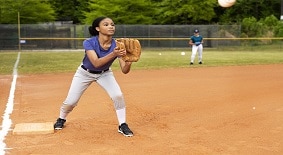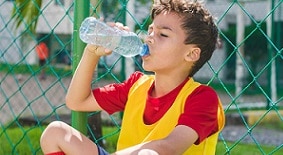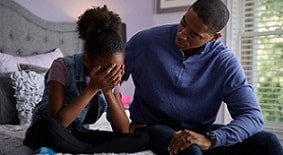Preventing Overuse Injuries in Teens
Overuse injuries occur over time, and their symptoms may be subtle. Learn the signs and types of overuse injuries that may affect teen athletes and ways to prevent them.
Playing sports can be one of the greatest joys in a kid’s life, but as more children and teens participate in organized sports, doctors are seeing an alarming increase in the number of teen athletes suffering from overuse injuries. Nearly half of all sports injuries in middle and high school students are caused by overuse.
“One thing parents of teen athletes may not be aware of is the increased risk for teens to sustain overuse injuries. Growing athletes may not understand that certain symptoms are signs of overuse and may try to play through the pain,” says Steve Kroll, MD, pediatric sports medicine primary care physician at Children’s.
Children and teens are at increased risk of these types of injuries because their bones are still growing and are more vulnerable to stress. Also, growing athletes may not understand that certain symptoms are signs of overuse and may try to play through the pain.
These injuries can be prevented, though, with the help of informed and watchful parents and coaches.
If your growing athlete has an overuse injury, it’s important to see a pediatric specialist. “At Children’s, we see these injuries day and day out. It is important that your teen sees a specialist who has the experience in recognizing and treating these injuries in growing athletes. Our goal is to get your athlete back to the field as quickly and safely as possible, not just this season but for many years to come,” says Dr. Kroll. Where you take your athlete matters because the treatment her growing bones get today will affect her future. At Children’s Healthcare of Atlanta, we have a pediatric-trained sports medicine team dedicated solely to caring for kids and teens.

An overuse injury is damage to a bone, muscle, ligament or tendon due to repetitive stress.
These injuries occur over time, usually from improper training or improper technique when performing repetitive motions (for example, running, overhead throwing or serving a ball in tennis). Overuse injuries occur in athletes playing all kinds of sports, from football and swimming to baseball, tennis and golf.
What are common overuse injuries?
- Glenohumeral instability
- Gymnast wrist
- Jumper’s knee
- Little League elbow
- Little League shoulder
- Osgood-Schlatter disease
- Patellofemoral pain syndrome (runner’s knee)
- Sever’s disease
- Shin splints
- Sinding-Larsen-Johansson disease
- Snapping hip
- Spondylosis
- Stress fractures
- Swimmer’s shoulder
- Tennis elbow
What causes overuse injuries?
Overuse injuries in teens frequently occur around growth plates, which are the areas of new bone growth near the ends of bones that make the bones lengthen as a kid grows. When an athlete performs the same motions over and over again, the body’s joints and the surrounding tendons and muscles involved in that motion become irritated and inflamed. If a teen’s growth plate is damaged, the bone may stop growing prematurely, which is called growth arrest. This is a serious problem and can change how the bone develops and functions, possibly making the bone grow unevenly.
Unlike traumatic injuries like fractures or cuts, overuse injuries can be difficult to diagnose because the symptoms are often subtle.
Watch out for these signs:
- Pain that gets worse when your teen is active
- Swelling
- Limping
- Limited range of motion
- Pain that continues for a while, worsens or lasts for a week or more following injury
As parents and coaches, it’s important to be aware that overuse injuries can be just as detrimental as fractures, sprains or concussions, even though they may not seem to be at first. If ignored or not treated properly, an overuse injury can gradually worsen.
If you think your child has an overuse injury, take her out of the game. Tell the coach about your concern, and call your child’s doctor.
One reason for the increase in these types of injuries is that more young children—as young as 7—are focusing on one sport year-round, which leaves these athletes vulnerable to overtraining, stress and burnout. According to the American Academy of Pediatrics (AAP), kids shouldn’t be allowed to specialize in a sport until they’re older than 15 or 16.
This may be because some studies show that children develop best when playing a variety of sports before puberty. They’re also less likely to lose interest in sports and stop playing.
Keep your teen in the game by applying some of these prevention pointers:
- Schedule your teen for an annual physical evaluation before participating in sports.
- Schedule a sports motion analysis session to have your teen’s mechanics analyzed. By using proper technique, athletes can lessen their risk of injury and help improve performance.
- Encourage your athlete to warm up properly before an activity by stretching or engaging in dynamic warm-up exercises, like jogging in place.
- Make sure training is increased gradually. Remember the 10% rule: Don’t increase training activity, weight, mileage or pace by more than 10% a week.
- Have your athlete take at least one day off from organized activity each week. She should also take at least three months off during the year (in one-month increments) between sports.
- Encourage your child to try a variety of sports involving different movement patterns and muscle groups. Young athletes who play the same sport year-round or sports with similar body demands (such as the overhead shoulder motions of swimming and pitching) are more likely than others to experience overuse injuries.
- Be sure your teen is wearing properly fitting sports equipment and protective gear, such as running shoes and helmets.
- Be aware that overuse injuries can occur during practice as well as during games.
To avoid repeat injuries, don’t let your athlete return to play until you know what caused her overuse injury.
When your child or teen has an overuse injury, the Children’s Sports Medicine Program is here to treat it. Our team specializes in treating growing athletes: We only work with kids and teens. We are clinical experts in treating athletes from 8 to 18 years old.
Our pediatric-trained team is equipped to recognize injuries to growth plates in kids and teens. Kids aren’t just small adults—even as teenagers, their bones are still growing and pose different challenges than adult bones. Injuries to growth plates can be difficult to spot, but our specialists know what to look for. As we treat your athlete, we can anticipate challenges and address or even prevent future problems in order to achieve the best outcome.
Our team consists of sports medicine primary care physicians, pediatric orthopedic surgeons specializing in sports medicine, sports physical therapists and certified athletic trainers whose goal is to help growing athletes decrease pain and restore or improve movement. Our sports medicine professionals guide athletes from assessment of their injuries through diagnosis, treatment and rehabilitation until they can safely return to play.
We provide a complete continuum of care that begins as soon as an injured athlete sees one of our specialists. Following an evaluation, our team develops a plan of care for each patient that includes techniques to manage and reduce pain, improve function for everyday activity, and return teen athletes to their sports not just for the season, but for many seasons to come.
Find a pediatric sports medicine specialist and learn more about our program today.
Stephen Kroll Jr., MD, a Sports Medicine Primary Care Physician in the Sports Medicine Program at Children’s Healthcare of Atlanta, is board-certified in pediatrics and sports medicine. Dr. Kroll specializes in the diagnosis and treatment of sports-related injuries, nonoperative musculoskeletal injuries, overuse injuries and concussion management. Dr. Kroll is also a founding member of the Pediatric Research in Sports Medicine (PRiSM) organization. Early morning appointments are available with Dr. Kroll at our orthopedic and sports medicine clinic at Children’s at Meridian Mark.
This content is general information and is not specific medical advice. Always consult with a doctor or healthcare provider if you have any questions or concerns about the health of a child. In case of an urgent concern or emergency, call 911 or go to the nearest emergency department right away. Some physicians and affiliated healthcare professionals on the Children’s Healthcare of Atlanta team are independent providers and are not our employees.
Contact Us 404-785-KIDS (5437)









